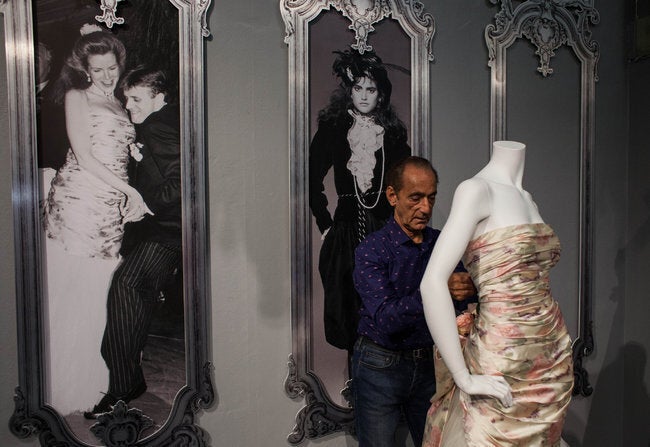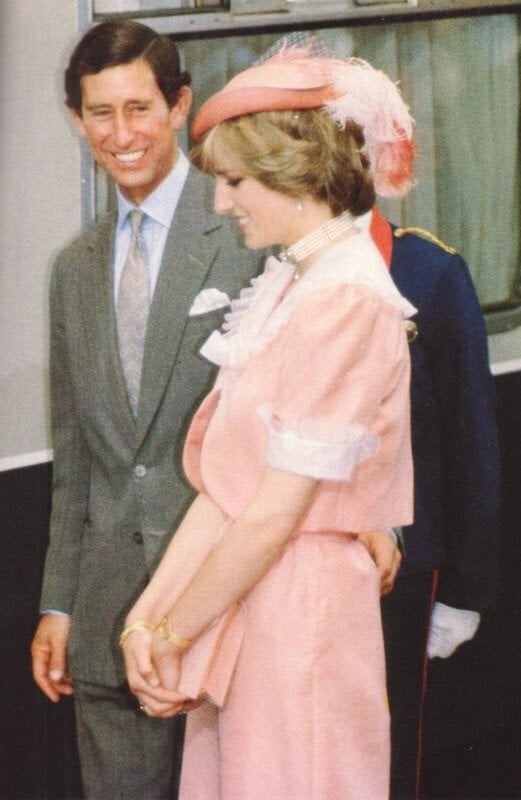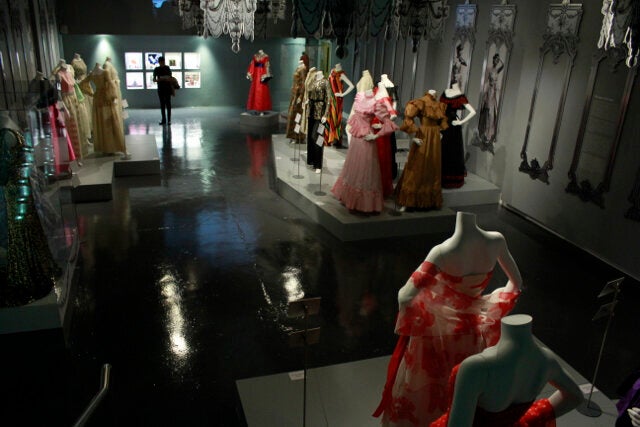To mark its ten year anniversary, the Fashion and Textile Museum ( FTM), London celebrates with the opening of its new exhibition- The Glamour of Bellville Sassoon. The show chronicles the amazing history of British couture label Bellville Sassoon. Established in 1953 by socialite Belinda Bellville, the label was originally styled Cie by Belinda Bellville. It quickly became noted for its sophisticated, elegant designs. By 1958, ever-increasing sales necessitated the addition of another designer. Impressing Belinda Bellville with his graduate collection from the Royal College of Art was the young David Sassoon. Theirs was to become a collaborative union spanning five decades. The year 1970 underscored their firm partnership with the renaming of the label to Bellville Sassoon.
Save for the Queen, Bellville Sassoon has achieved the honour of having dressed every female member of the British royal family as well as many internationally recognised ladies of fashion distinction: Jacqueline Kennedy, Elizabeth Taylor, Helen Mirren, Jerry Hall and Madonna- to name but a few.
It is fitting that for its milestone anniversary, FTM proudly organised a comprehensive retrospective in tribute to the cumulative work of Mr. David Sassoon- premier couturier and founding trustee of FTM.

David Sassoon at the Fashion and Textile Museum
(image from nytimes.com)
...
The Museum is hosting several presentations to accompany the exhibition. I attended the early morning event of continental breakfast, followed by tour: Behind-the-Scenes at Bellville Breakfast. Navigating the small and attentive group was the eminent designer himself- David Sassoon. Mr. Sassoon was introduced to the attendees by FTM director, Cecile Joicy.
Articulate in his design expression and expressing of his designs, Mr. Sassoon provided anecdotal tales of dresses worn and the ladies who wore them. By imparting these personal reminiscences, he breathed a life quality into the garments. Examining the dresses with knowledge of their back-story, added a further dimension to my appreciation of their relevance.
The viewing commenced in a separate room off the main exhibition area. There displayed are dresses which were designed for several ladies of the British royal family. They are of significance for future research on period dress and historic personages .
It was in this room that some of Mr. Sassoon most distinct memories were retold. In particular, he referred to the peach hued skirt suit worn, by the late Princess Diana for her honeymoon leave taking. Viewing the suit prompted the telling of a nervous Lady Diana in the months leading up to her widely anticipated marriage to the future king, Prince Charles. Mr. Sassoon spoke of her tearfulness and anxiety during fittings- a not uncommon emotion of many a young bride-to-be, especially one soon to recite her vows televised before millions.

Princess Diana attired in her honeymoon leave taking suit
(image from flickr.com)
...
David Sassoon would go on to design over 70 garments for Princess Diana. The two enjoyed a happy, relaxed client/designer relationship. He credits Princess Diana with changing the public perception of royal dress. Due to her fashion sensibilities, the image of royal-wear was revolutionised from that of the conservative and expected to one of glamour and the unpredictable.
Although not part of the exhibition, Mr. Sassoon, spoke of the debutante dress designed for the eighteen year old Camilla Shand, now the Duchess of Cornwall- second wife of Prince Charles. However, in the show is a hand-painted jacket and skirt ensemble designed for the Duchess of Cornwall, which features an image of her dog on the back of the skirt- a whimsical touch.
He also reflected on a visit to Buckingham Palace, of many years past. He was asked to design a bridesmaid dress for the young Princess Anne. The Queen was present and heavily pregnant with the future Prince Andrew. The fitting went smoothly, without incident. Yet, in taking his leave of the Queen, bowing and walking backwards, he up-setted a water bowl placed on the floor for her pet Corgis. A bit embarrassed, Mr. Sassoon was relieved that the Queen made no comment. As he reminded us, those were days of liveried servants and strict protocol when in royal presence. One hoped to avoid even the slightest mishap. This tense reserve, when in royal presence, differed dramatically to the feeling of relative ease created by Princess Diana.
The bridesmaid dress made for Princess Anne is not part of the collection, however a more recent one for the Princess Royal is included: a lovely powder blue dress based on a Wedgewood plate pattern. Also on display is the dress worn by Princess Alexandra of Kent for the wedding of Prince William to Kate Middleton. Bellville Sassoon would go on to design dresses for the other royal ladies including Sarah Ferguson, the Duchess of York- whose early fashion advances required a bit of gentle guidance.
Leaving the small outer room of royal dresses, the exhibition continues in the main ground space and upper balcony area. Here displayed are dresses exemplar of Bellville Sassoon from the 1960s to the present.

Fashion and Textile Museum, London
(image from the upcoming.co.uk)
...
As with any undertaking, nothing can be of permanence for change is inevitable. The dictates of today's fashion market demand impeccably tailored ready to wear (RTW) clothing- mass produced garments with couture inspired detailing. In response to this requirement, Mr. Sassoon observes that a designer "needs to understand trends ... and can not design clothes stuck in a time zone." With emphasis on RTW in mind, Irish designer Lorcan Mullany was approached to be the third member of the Bellville Sassoon family. Mr. Mullany joined in 1987, creating under the Bellville Sassoon label and his own brand. In 1989, all was incorporated into one with the name change to Bellville Sassoon Lorcan Mullany.
During the 1990s, the label became accessible to the wider market through RTW fashion. This outreach was initially championed by Bellville Sassoon during its early years. In the mid-1960s, they partnered with the pattern company, Vogue Butterick to create Bellville Sassoon dress patterns for home dress- making. As Mr. Sassoon mentioned, the 1960s saw a renewed interest in crafting home-sewn garments. Astute in the business of fashion, Bellville Sassoon actively participated in this growing market. In acknowledgement, a few dresses made from the Vogue Butterick patterns are featured in the exhibition. Innovative approaches to design and business have been integral to the company's staying strength.
Complementing the dresses in the collection, are many design sketches. These drawings, accomplished by Mr. Sassoon's assistants, are wonderfully detailed works. As with many creatives, drawings initiate the artistic process and are often considered pieces of art in their own right. Such is the case with these colourful sketches.
As the time with Mr. Sassoon drew to a close, I was as much intrigued with the man as with the clothing he created. Mr. Sassoon was engaging, dynamic, witty and charming- gentlemanly in the classic sense.
Last year he officially handed over full design control to Locran Mullany. Yet, his enthusiasm and love for his many years of work at Bellville Sassoon remains very much in evidence. What has made this label an incredible fashion force continues: the David Sassoon legacy of beautiful design.
...
The Glamour of Bellville Sassoon
is presented at the Fashion and Textile Museum, London.
Until 11 January 2014
The exhibition is must-see viewing for all those interested in exploring an era of British fashion couture history which was dominated by the Bellville Sassoon salon.
...
An Evening with David Sassoon
offers an opportunity to hear the designer discuss
the history of the label. There is no tour scheduled
for this event.
Thursday, 24 October 2013
Fashion and Textile Museum, London